|
Click pictures for a larger version.
UPDATE! November 25th, 2014

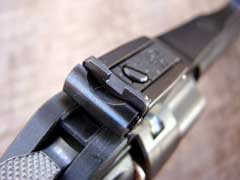



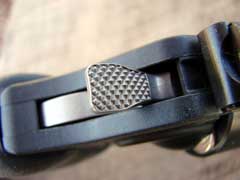


  
UPDATE! December 19th, 2013

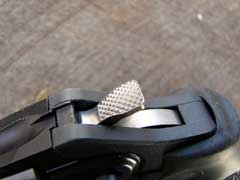

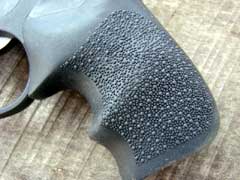



  

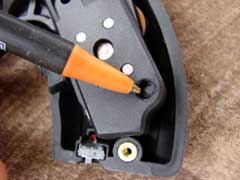
Locating points are molded into the grip frame to
position the Crimson Trace Lasergrip.


On/Off switch (top) & Activation switch (bottom) for the Crimson Trace
Lasergrip.









Crimson Trace Lasergrip.


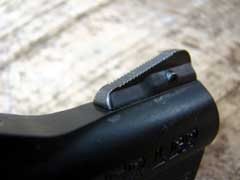

Sights are fixed blade front & rear notch.

Accuracy testing was done in the Ransom rest.

Most accurate factory load tested was Buffalo Bore's
Plus-P 125-grain JHP.

Shot pattern at eight feet would be very effective on
snakes.
|
|
  
UPDATE! December 19th, 2013
Ruger has introduced
a very useful addition to their line of excellent compact pocket
revolvers. Titled the LCRX, the newest addition is a Plus P
rated 38 Special variation that differs from the original LCR in
that it has an exposed hammer, with single-action fire
capability. Like
the original, the LCRX is a lightweight, weighing in at 13.5
ounces on my scale. It has a butter-smooth double-action trigger
pull that measures eight and one-half pounds resistance, and a
single-action pull that weighs in at four and one-quarter pounds
average. While the original LCR is a fine pocket gun for social
work, having the option of a crisp single-action pull with the
LCRX makes it much easier for most of us to make a precision
shot, if necessary.
For more information on the extensive line of
Ruger firearms and accessories, go to www.ruger.com.
For the location of a Ruger dealer near you,
click on the DEALER FINDER at www.lipseys.com.
To order a Ruger firearm online, go to www.galleryofguns.com.
To
order quality ammunition online, go to www.buffalobore.com,
www.doubletapammo.com,
www.theamericanmarksman.com,
and www.luckygunner.com.
Jeff
Quinn
  
Back in January of this year, we were given
the go-ahead to report upon the new
lightweight revolver from Ruger called the LCR. That early
report was based solely upon the limited time that I spent with
the revolver at the New Hampshire factory in early December.
Since then, the revolver has also been featured in a couple of
paper magazines, and those reports were also based upon time
that the authors spent at the Ruger factory. All previous
reports of the LCR were based upon those early prototypes, and I
have been awaiting the delivery of a production revolver. It is
finally here.
The LCR arrived a few days ago, as production
guns started shipping the week of March 25th. Since
its arrival, I have been feeding it every type of .38 Special
standard and Plus P ammunition that I could find. The LCR weighs
in at 13.5 ounces with the Hogue grip, and 13 ounces exactly
with the optional Crimson Trace Lasergrip. The Hogue grip is a
bit more comfortable to shoot, but the Lasergrip is more
compact, lighter, and of course, contains a laser sighting
device. I am a firm believer in
using a good, high quality laser on a defensive weapon, and
the CT Lasergrip is as good as it gets. They are very reliable,
and most importantly, they help me to place my shots much more
accurately in low light. In the dark, standard handgun and rifle
sights are almost impossible to see, but the Crimson Trace
Lasergrip quickly and accurately gets on target, showing exactly
where that bullet will land. The LCR has a good set of
easy-to-see sights, but in the dark, they are useless. Ruger and
Crimson Trace worked together on the design of the grip frame so
that it would accommodate the Lasergrip, and hold it perfectly
in place. My LCR came from the factory with the standard grip so
that I could compare, but the Lasergrip has been waiting here
for about a month. The grip portion of the Lasergrip marries a
hard polymer on the sides with a softer compound on the front
and rear surfaces. The sides are checkered, but not sticky like
some synthetic grips. This allows a good hold on the weapon,
without it having the tendency to hang up on clothing.
The LCR will fit some holsters that are made
for the S&W J-frame revolvers, but not all. While they are
the same size, the shape of the LCR trigger guard is different.
Rob Leahy of Simply Rugged Holsters in Alaska already has
holsters for the LCR. His Sourdough Pancake is a very versatile
belt holster, allowing strong-side or crossdraw, and he also has
optional belt loops that allow the holster to be worn inside the
pants. Simply Rugged also has a very good pocket holster, to
keep the revolver oriented correctly in the pocket, and to
protect both the gun and pocket from wear.
Accuracy of the LCR was tested at twenty-five
yards, from both a Ransom Machine Rest
and from a hand-held rested position. Most ammunition grouped a
cylinder full into around three inches at that distance. The
best groups were turned in by the Buffalo Bore Plus P 125 grain
hollowpoint that uses the excellent Speer Gold Dot bullet. This
ammo grouped into just over two inches, consistently. The
barrel/cylinder gap on the test gun measured six one-thousandths
(.006) of an inch. I like the gap a little tighter, but can
certainly live with that. The trigger pull is one of the best
features of the LCR. The two that I fired at the factory had
very good, butter-smooth trigger pulls. The few that I handled
at SHOT did as well, so I was
hopeful that the production guns would also have good trigger
pulls. I was not disappointed. My sample gun has what is
probably a perfect trigger pull for a small defensive revolver.
Measuring seven pounds, ten ounces, it feels even lighter. The
trigger is wide and smooth on the surface, and the pull feels
more like five pounds to my finger. Ruger has spent a lot of
time and money developing this trigger, and their efforts have
paid off. The polymer grip housing holds all of the fire control
parts, and they all come out of the mold ready to go. No
hand-fitting of the internal parts is required, and every LCR
produced should have this same trigger pull.
While on the subject of this trigger, there
is already talk on the Ruger
Forum regarding the instruction that Ruger puts in their
manual to always fully return the trigger to its forward
position between shots. This is common knowledge, or so I
thought, with every double-action revolver ever made. This
question was brought up by someone who is supposedly a gun
writer with over 100,000 rounds of ammo fired through
double-action revolvers, but he did not know that the trigger
must be returned to its forward position before firing
subsequent shots. Perhaps he has a fully automatic revolver. Now
keep in mind that the gun writer had never fired the LCR before
making these statements. However, because Ruger placed that
message in the manual for those of whom this might be their
first double-action revolver, some folks, who have never fired
the LCR, are suggesting that this might be a flaw with the LCR.
That is nonsense. Assuming that the gun is flawed because Ruger
thoroughly instructs the owners on the use of the firearm is
idiotic, to be kind. This is a topic that I would have never
thought to cover in a review of a double-action revolver, but
since it appears that this is not common knowledge, I do so to
lay that to rest, hopefully. With any double-action revolver
ever built, the trigger must be returned to its forward position
before firing the next shot.
To reduce weight, the cylinder is heavily
fluted. It has an unusual look, reminiscent of some of the old
cap-and-ball revolvers of the nineteenth century. I like it. The
cylinder is made of stainless steel, as are the barrel and
internal parts. The cylinder frame/barrel shroud is of aluminum
alloy construction.
As mentioned above, I have been cranking a
lot of ammo through this LCR. I clocked several different loads
over one of my chronographs to see what velocities were achieved
from the LCR’s one and seven-eighths inch barrel. Velocity
readings were taken at a distance of twelve feet from the
muzzle. Velocity readings are listed in feet-per-second. JHP is
a jacketed hollowpoint bullet. LRN is a lead round-nosed bullet.
LSWCHP is a lead semi-wadcutter hollowpoint. PowRBall
is a specialty bullet from Cor-Bon loaded with a jacketed
hollowpoint bullet containing a polymer ball inserted into the
hollow of the bullet nose. DPX is a Cor-Bon load that uses a
homogenous copper hollow nose bullet. LWC is a lead wadcutter
bullet. Glaser is a pre-fragmented core inside a bullet jacket.
Bullet weights are listed in grains. SV is standard velocity .38
Special ammunition, and +P is .38 Special ammunition loaded
above standard pressure levels. The LCR is rated for use of +P
ammunition. Velocity readings were taken with an air temperature
in the 65 degree Fahrenheit range, at an elevation of
approximately 500 feet above sea level. As expected, reliability
was one hundred percent perfect. There were no failures to fire,
and with every ammo type tested, extraction of the fired cases
was easy and ejection was quick.
| Ammunition |
Bullet Weight |
Velocity |
| Buffalo Bore LWC SV |
150 |
912.5 |
| Buffalo Bore JHP SV |
125 |
872.6 |
| Buffalo Bore LSWCHP SV |
158 |
866.9 |
| Buffalo Bore JHP +P |
125 |
1053 |
| Buffalo Bore LSWCHP +P |
158 |
985.8 |
| Cor-Bon DPX +P |
110 |
878.7 |
| Cor-Bon JHP +P |
110 |
919.9 |
| Cor-Bon PowRBall +P |
100 |
995.1 |
| Cor-Bon Glaser +P |
80 |
1194 |
| Winchester USA LRN SV |
150 |
733.1 |
Any of the +P ammo listed above would be a
good carry load, and for those who want a lot less recoil, the
standard velocity Buffalo Bore loadings are made to expand at
low velocity. Recoil was brisk but very controllable, even with
+P ammo, as can be observed in the video. We shot the video with
the Lasergrip attached, and still the revolver was very easy to
control. I prefer the size and feel of the Lasergrip to the
standard Hogue grip, even though the Hogue is a bit more
comfortable to fire. The advantages of the smaller grip in
concealment, along with the reliable laser of the Crimson Trace
grip is well worth the trade-off, and is also worth the extra
cost. In a fight, you need every edge that you can get.
Remember, the thug attacking you has planned his evil deed, and
is acting with forethought. You are reacting, and every split
second counts. The police are not there to help, and all you
have is your handgun and training. The laser is not a gimmick.
It can and will help you to more accurately place those precious
few bullets on target. In a fight, any handgun is a compromise
of concealability, power, controllability, reliability, recoil,
and ease of use. If the handgun is too little, it will not be as
effective. If too large, you will leave it at home. It seems
that the compact five-shot .38 Special revolver has become one
of the most popular weapons of choice for those who choose to go
heeled. It is a good balance of all those factors listed above.
If I know that I am headed for a fight, I want something larger
with more power, preferably crew-served. However, like most of
us, as I go through my daily life, I carry something a bit more
compact, with a lot less power. For the last six years or so, my
everyday carry gun has been a Smith &
Wesson .38 Special 342PD loaded with Glaser ammunition. It
has a concealed hammer, a Lasergrip, is lightweight, and
reliable. This LCR fits the same description, the same pocket,
and sells for a much lower price. Whether or not it will replace
the S&W in my pocket remains to be seen. I like both, and
will carry both, at least for a while.
Back in 2006, I was sitting in a meeting with
a few Smith & Wesson executives, along with famous gun
writers Leroy Thompson and Frank
James. As the S&W folks were asking the three of us for
ideas, Frank suggested that someone should produce a
polymer-framed revolver. Frank is, in addition to being a fine
writer, a farmer who produces a lot of grain and beans on his
fertile Indiana farm. I thought that Frank had either lost his
mind from too many hours alone in the cab of his tractor, or
that he had been sniffing the farm chemicals. I thought that the
idea of a revolver with a polymer frame would never fly. I was
wrong, and owe Frank James an apology, and the beverage of his
choice. Already, the LCR is widely popular, and Ruger has taken
orders for many thousands of them. The suggested retail price of
the LCR at the time of this writing is $525 US and $792 US for
the standard model and the Lasergrip model, respectively.
Check out the full line of Ruger products
here.
For the location of a Ruger dealer near you,
click on the DEALER FINDER at www.lipseys.com.
To order a Simply Rugged holster, go to www.simplyrugged.com.
To order any of the high performance ammo
listed here, go to www.buffalobore.com
and www.cor-bon.com.
Jeff
Quinn
  
Got something to say about this article?
Want to agree (or disagree) with it? Click the following link to
go to the GUNBlast Feedback Page.
|
|
Click pictures for a larger version.
UPDATE! November 25th, 2014




Some of the author's favorite ammo for the LCRx.

Target fired offhand at ten yards, using Remington's 125-grain
+P JHP Ultimate Home Defense load.


  
UPDATE! December 19th, 2013








  
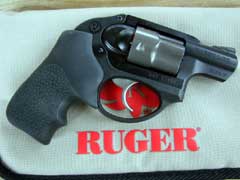
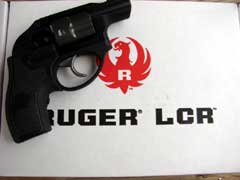
Pistol rug & white cardboard box.



Ruger LCR compared to Smith & Wesson J-frame
Model 342PD.







Standard grips are very nice stippled rubber by
Hogue.



Ruger's internal lock is located under the grips.



|
![]()